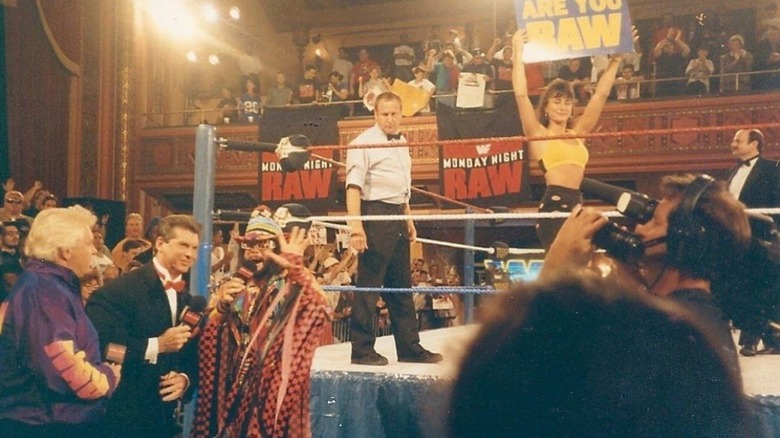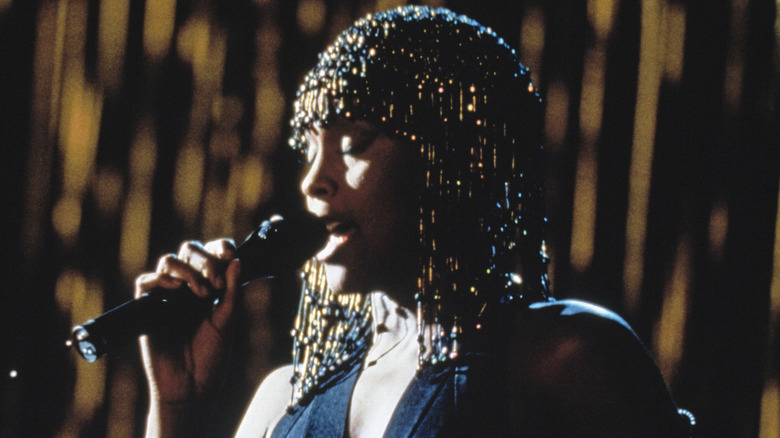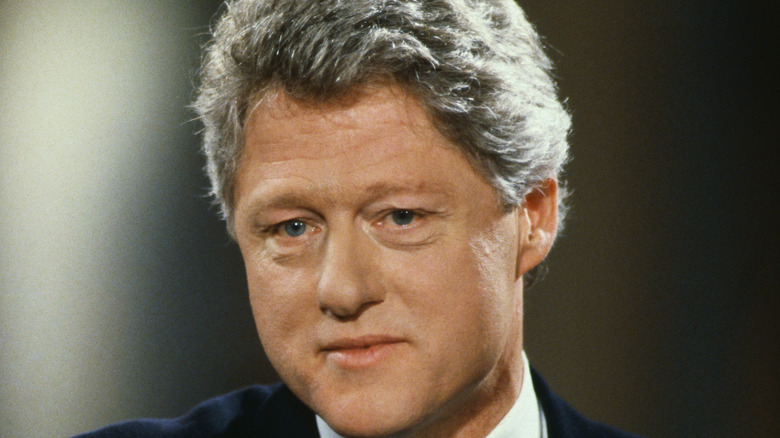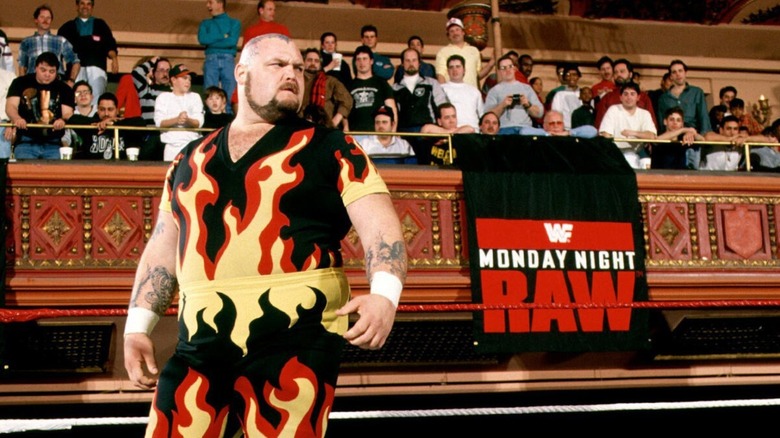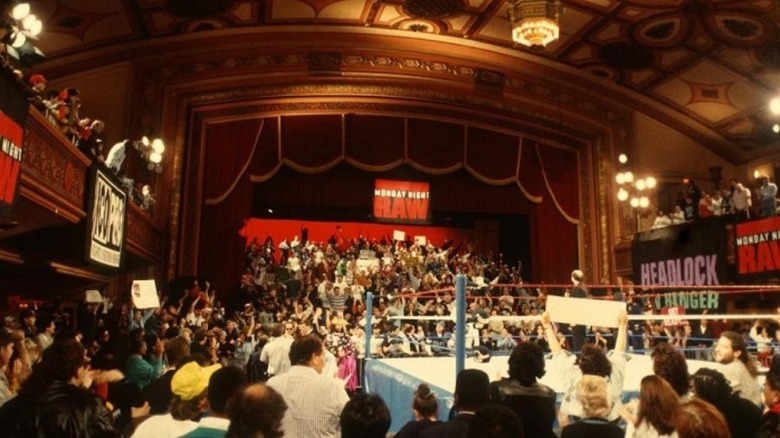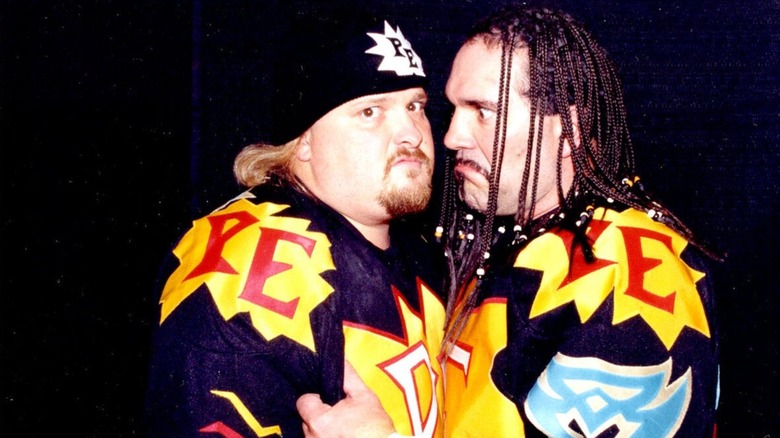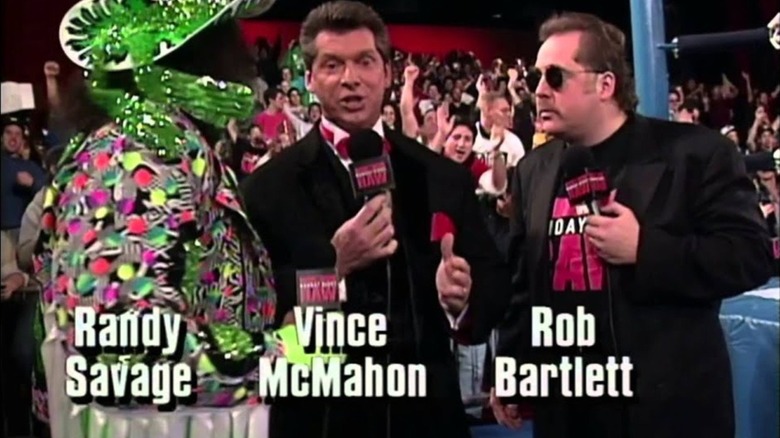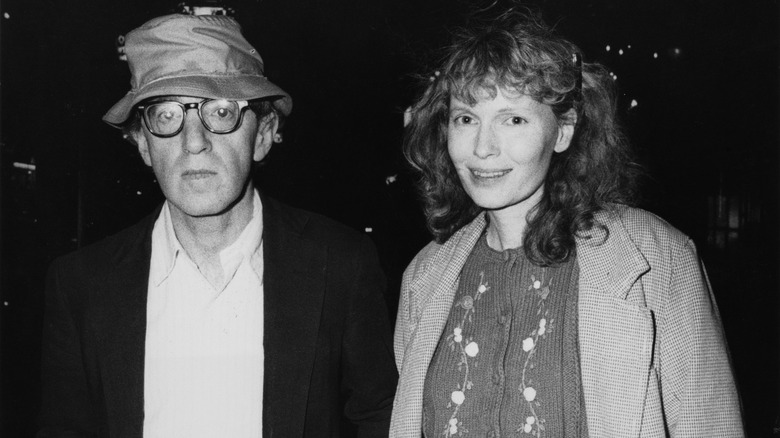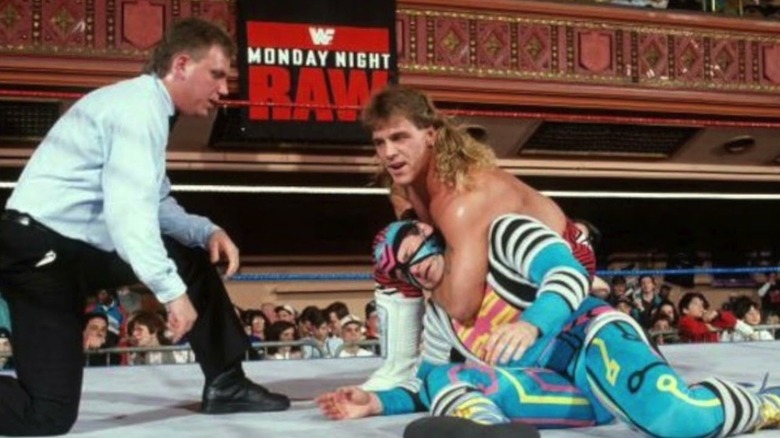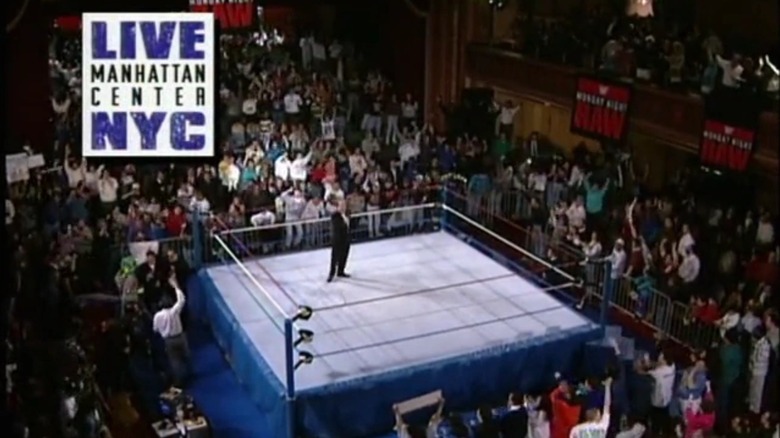What The First Episode Of Monday Night Raw Was Really Like
On December 30, 2024, cable television bid farewell to its longest-running weekly show. "WWE Raw" had been on the air for almost 32 years exactly with 1649 episodes in that time with limited pre-emptions, but it has since moved to its new home of Netflix. Professional wrestling might not be everyone's cup of tea, but despite that sentiment, "Raw" can legitimately put itself alongside the likes of "Saturday Night Live," "The Simpsons," and "The Tonight Show" as a true staple of American television.
Given "Raw's" new home is the biggest streaming service in the world, some newer fans who might be watching WWE for the first time might want to watch the show "The Netflix Way," by essentially binging every episode from the very beginning until Netflix themselves asks "are you still watching this?" In theory, that idea isn't out of the ordinary as some people might think that to understand what's going on in 2025, they would need to watch everything since 1993. Spoiler alert, you don't, and considering "Raw" has gone from one to two, to three hours over the years, it may genuinely take someone 32 years to actually watch every show.
But for those who are curious as to what "Season 1, Episode 1" of "Raw" was like, we've got you covered. This is going to be a little crash course on what life was like in the Manhattan Center on the evening of January 11, 1993, as well as some extra little nuggets of information to set the scene of what the world was like at the time. From comedians on commentary to Bobby "The Brain" Heenan not being allowed in the building, all the way up to how many people tuned in, this is what the first episode of "Raw" was like.
The Pop Culture Lanscape Of 1993
32 years is a long time, so much so that the amount of time between the first episode of "WWE Raw" and the 2025 debut on Netflix is almost the same as the time between "Raw's" debut in 1993 and The Beatles performing under that name for the first time in February 1961. With that in mind, you can imagine that a lot has changed in the world in over three decades.
Turning back the clock to the week "Raw" debuted, if you wanted to go to the movies, the one that had everyone talking was Disney's "Aladdin," which was released in December 1992, but had been received so well that it continued to dominate the domestic box office heading into 1993. However, of the week "Raw" debuted, "A Few Good Man" snatched the number one spot for that week before being toppled by "Aladdin" once more, with other hit movies at the time being "Forever Young," "Scent of a Woman," and "The Bodyguard."
Speaking of "The Bodyguard," if you happened to turn on the radio in January 1993, you would hear the iconic vocals of Whitney Houston and her cover of "I Will Always Love You," which had already been sitting pretty at the top of the Billboard Hot 100 for seven weeks by the time "Raw" aired. The song would not only stay top of the charts for a further seven weeks but would also top the year-end charts as the most bought and listened to song of the year.
As for TV, the more things change, the more things stay the same much like many Monday nights in 2024, it was the NFL that dominated the TV ratings, with the NFC Championships winning the week with a whopping 60.4 million viewers on CBS.
What Was Happening In New York City?
When it comes to what was happening in New York on January 11, 1993, there were still a number of big headlines spilling over from 1992.
The biggest one by far was the people of New York (and the rest of the country for that matter) were getting ready for the Presidential Inauguration of Bill Clinton, who won the 1992 Presidential Election over George H.W. Bush and Ross Perot, the latter of whom announced on January 11 that he would be returning to politics despite not winning a single state in the election. In the city itself, mayor David Dinkins was not very popular due to the economic decline, leading to the state of New York having an unemployment rate of 13.4%, the highest since the end of the Great Depression in 1939.
It wasn't all bad news as the January 11 edition of "Eyewitness News" that broadcast on Channel 7 WABC has been uploaded to YouTube, where one of the biggest stories that day was a woman by the name of Vida Boateng ended up giving birth to her daughter on the subway. People were reportedly not thrilled about this as the subway had to be stopped due to the medical emergency. Elsewhere in the state, a woman was arrested in Hornell for leaving her two daughters home alone over the holiday period. Two pit bull's attacked members of a local area in Elmont, and a Bushwick area saw two men arrested for illegally handling rotting garbage.
Finally, January 11 also saw the legendary radio host Howard Stern air his first show on WKBW in Buffalo just a few months after he became the first person to have a number one show in New York and Los Angeles at the same time.
Why Was WWE Raw Created?
WWE and Vince McMahon have credited "Raw" for being the first of its kind, a landmark moment in professional wrestling, a moment where there is a distinct line in the sand of what came before and what came after. All of which is true, except one little detail is missing from that description; WWE kind of needed "Raw" in 1993.
By the end of 1992, the company had run eight WrestleMania's, the first international SummerSlam at Wembley Stadium, and had sold out Madison Square Garden more times than anyone could remember. However, they were no longer in the golden era of the 1980s, Hulkamania was no longer running wild, and it was evident in the facts and figures. Ticket sales were down, merchandise sales were down, and when it came to their programming, shows like "The Wrestling Challenge," "Superstars," and "Prime Time Wrestling" had all become stale to the point where a big change needed to happen to keep people interested in the product.
The way WWE thought they would get people back into the product was a weekly show that aired live on prime-time cable television, complete with a different presentation to what had become the norm with big NBA-style arenas. Bruce Prichard revealed on his "Something to Wrestle" podcast that the original plan for "Raw," or whatever the show was going to be called was to have the company build an arena in the warehouse section of where the WWE television studio was that could hold between 500 and 1,000 people. This was the plan as the company needed to save money due to dwindling interest, but the company ended up going with the Grand Ballroom at the Manhattan Center, that choice ended up being very costly despite the venue's size.
It Wasn't Just Cost's WWE Had Issues With At The Manhattan Center
These days, fans are probably more familiar with the Hammerstein Ballroom side of the Manhattan Center thanks to companies like ECW, Ring of Honor, and even AEW as of late, but the Grand Ballroom has a special significance for WWE as the home of "Raw's" debut, even if the venue was initially a pain in the a**.
Bruce Prichard not only brought up the issue of the Manhattan Center being more expensive to run than what the company had originally anticipated, but the fact that the venue wasn't really built to have a big live wrestling show. He explained that because the Grand Ballroom wasn't on the ground floor, the ring had to be taken up in a customer elevator in small pieces rather than loaded in regularly like they would have done in an arena and stadium. Because of the size of the venue, WWE also had problems trying to fit all of their equipment into the vicinity of the ballroom that would let them air the show live on cable.
While Prichard cited the presentation and cost as a reason for the venue's choice, Vince McMahon was the one who wanted the Manhattan Center. McMahon explained in an interview that WWE had always considered New York City the company's home territory, as well as the home of entertainment across the world. Madison Square Garden had been "the mecca" for wrestling and entertainment in the city, so McMahon wanted to get as close to the arena as possible given that the company wouldn't be able to sell out the venue in the climate they were in, and with that, the Manhattan Center was chosen, and became synonymous with WWE's flagship show.
Familiar Faces Were Involved In The Dark Matches
Dark matches are a normality in wrestling as they are designed to give local, or up-and-coming competitors a chance to showcase what they are made of in the hopes of potentially landing a deal with a major company, while also getting the fans in attendance warmed up for the show they are about to see. This was no exception for "Raw's" debut, but there were a few familiar faces involved in the night's proceedings.
Former WWE Champion Bob Backlund opened up the night with a disqualification victory over Damien DeMento, but it was the second dark match that has become something of a trivial nugget for wrestling fans as The Cheetah Kid defeated Johnny Rotten (not to be confused with the lead singer of The Sex Pistols). These two men had made a name for themselves on the North East independent scene, but their biggest successes were still ahead of them as Paul Heyman would see the chemistry the two men had and make them one of ECW's first major acts; Rocco Rock and Johnny Grunge, also known as The Public Enemy.
Following their success in ECW, they would have another dark match almost three years later before the 1995 Survivor Series pay-per-view where they challenged The Smoking Gunns for the WWE Tag Team Championships. However, once their ECW deals were up, they joined WCW at the start of 1996 instead, but they ended up having a brief run with WWE during the Attitude Era where their most famous moment was being senseless by The Acolytes. Rock passed away in 2002, while Grunge passed away in 2007, leaving no record of what they thought about playing a small part in one of the most historic nights in wrestling history.
A Sense of Humor on Commentary
The broadcast team for the first episode of "Raw" is certainly surreal through a modern lens as there are a few people on the show that some fans might look at and go "Wait, who is that?" Arguably the one person who sticks out like a sore thumb on the show is comedian Rob Bartlett, who joined Vince McMahon and "Macho Man" Randy Savage on commentary. Bartlett was known for being a rather controversial figure in the early 1990s, but he was even more controversial on commentary for two main reasons; his jokes about racial stereotypes, and his lack of knowledge of wrestling as a whole.
The latter of those two factors certainly annoyed fans in 1993, especially when Bobby Heenan was "replaced" on commentary for the debut show, with the highlight for fans who watch back in retrospect being him calling Doink The Clown "Dork The Clown," which led Savage to mutter "his name is Doink." However, the former of those points were on full display throughout the night, which included multiple jokes about Yokozuna wearing a diaper and Bartlett saying to McMahon "THAT'S ONE BIG ORIENTAL!" Yikes.
Fortunately, for fans, Bartlett left the company after just three months, a decision that even Bartlett himself wasn't too fussed about. In an interview with Inside The Ropes, Bartlett explained that the first episode of "Raw" was a lot of fun to do, and his jokes about Yokozuna set the tone for what people should expect from him. He thanked McMahon for taking a chance on him, but even McMahon knew it wasn't working out and the comedian resigned, with Bartlett stating that he felt his style of comedy didn't work with a product that didn't take itself too seriously in the first place.
Trying To Stay Relevant
If you watched the January 6, 2025 edition of "Raw" on Netflix and got the sense that WWE was really trying to showcase how accepted and popular they were with how many celebrities were shown in the crowd, at least they had celebrities in the crowd, because in 1993 the company took a very different route. Towards the end of the episode, McMahon was running down what fans should expect on the following week's show when, out of nowhere, McMahon stated that movie director Woody Allen and Golden Globe Award winner Mia Farrow would be facing off in a Steel Cage match.
For context, Allen and Farrow had been in a relationship for 12 years, but in August 1992, it was alleged that Allen had molested Farrow's adoptive daughter Dylan, who was aged seven at the time. These allegations had come less than a year after Allen had an affair on Farrow with another one of her adoptive daughters Soon-Yi Previn. So what better way to capitalize on the publicity of having two A-list celebrities having their dirty laundry aired out in public than to have McMahon not only promote a fake steel cage match but play the whole thing STRAIGHT AS AN ARROW WITH NO SENSE OF SARCASM TO BE SEEN...YES, REALLY!
This was the simple case of McMahon, or some of the higher-ups in WWE, wanting to get a little bit of publicity with a poorly placed joke, and it went down about as well as a fart in church. The whole saga between Allen and Farrow has been well documented so if you want to find out more details, almost everything is available online, but this awful joke was so bad, that it would make Rob Bartlett's jokes sound like gold.
Shawn Michaels on Being in the First Raw Title Match
The first televised match in "Raw" history was Yokozuna versus Koko B. Ware, the first tag team match in "Raw" history was The Steiner Brothers versus The Executioners, and the first main event in "Raw" history was The Undertaker versus Damien DeMento (who as we now know pulled double duty on the night). However, the match that many consider to be the match of the night was the first title match in "Raw" history as Shawn Michaels defended the WWE Intercontinental Championship against Max Moon.
25 years after the show's debut, WWE returned to the Manhattan Center for "Raw 25" in 2018, where half of the show took place in the Grand Ballroom (with the other half taking place in the Barclays Center in Brooklyn). During the day leading up to the show, Michaels, who appeared at the Grand Ballroom that night, got to re-familiarise himself with the iconic venue and opened up about some of the memories he had of "Raw's" debut.
"I remember it being against Max Moon, a.k.a. Paul Diamond. The one good thing was being live, our first live telecast, and all the unknowns that were going on with live television, dealing with commercial breaks and stuff like that, trying to figure all that stuff out. It was very comforting to know that I was going to be in the ring with somebody who I was incredibly comfortable with and very familiar with. So at least on top of all the anxiety you already have about it being this unbelievably new world that we were stepping into, that was the one comfort that was there, about being in the ring with a guy who you knew was going to be there for everything you needed."
WWE Raw Viewership & Ratings Report, 1/11/1993
Back in 1993, sites like Wrestlenomics and The Programming Insider who provide all of the TV rating information in the modern era did not exist, and truthfully this isn't going to be a case where I break it down by average viewership and the key 18-49 demographic because, quite frankly, that information is not available. What is available is the TV number "Raw" drew, a 2.5, which is a number that shows these days would be scrambling to get, and despite the show being something that is rather tough to look back on through modern eyes, no one can deny that the first episode of "Raw" was a big success.
Had it not been a success, the show wouldn't have lasted on cable TV for 32 years, it wouldn't be available to stream on Netflix today, and I would be writing a very different piece, one full of negativity and how WWE squandered their big opportunity to make a lasting impression on American television. However, it was a success, and even though the "new generation" era could have genuinely seen WWE go out of business, "Raw" was still a proven ratings draw, and by the end of the Attitude Era, it had become a pop culture juggernaut.
So there you have it, a crash course on everything weird and wonderful about the first episode of "Raw" from January 11, 1993. The world was a very different place, and WWE was a very different company. The show itself isn't very eventful, and outside of cultural significance, there isn't anything "must see" on display. Having said that, it is one of the most important nights in wrestling history, and as fans, we should all be thankful it went as well as it did.
